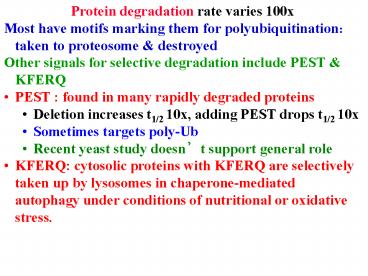Protein degradation rate varies 100x - PowerPoint PPT Presentation
Title:
Protein degradation rate varies 100x
Description:
KFERQ: cytosolic proteins with KFERQ are selectively taken up by lysosomes in chaperone-mediated autophagy under conditions of nutritional or oxidative stress. – PowerPoint PPT presentation
Number of Views:140
Avg rating:3.0/5.0
Title: Protein degradation rate varies 100x
1
- Protein degradation rate varies 100x
- Most have motifs marking them for
polyubiquitination taken to proteosome
destroyed - Other signals for selective degradation include
PEST KFERQ - PEST found in many rapidly degraded proteins
- Deletion increases t1/2 10x, adding PEST drops
t1/2 10x - Sometimes targets poly-Ub
- Recent yeast study doesnt support general role
- KFERQ cytosolic proteins with KFERQ are
selectively taken up by lysosomes in
chaperone-mediated autophagy under conditions of
nutritional or oxidative stress.
2
- Protein degradation in bacteria
- Also highly regulated, involves chaperone-like
proteins - Lon (also in mito)
3
- Protein degradation in bacteria
- Also highly regulated, involves chaperone like
proteins - Lon
- Clp (also in chloroplasts)
4
- Protein degradation in bacteria
- Also highly regulated, involves chaperone like
proteins - Lon
- Clp
- FtsH in IM (also in cp and mito)
5
PROTEIN TARGETING All proteins are made with an
address which determines their final cellular
location Addresses are motifs within proteins
6
PROTEIN TARGETING All proteins are made with
addresses which determine their
location Addresses are motifs within proteins
Remain in cytoplasm unless contain information
sending it elsewhere
7
PROTEIN TARGETING Targeting sequences are both
necessary sufficient to send reporter proteins
to new compartments.
8
- PROTEIN TARGETING
- 2 Pathways in E.coli http//www.membranetransport.
org/ - Tat for periplasmic redox proteins thylakoid
lumen!
9
- 2 Pathways in E.coli
- Tat for periplasmic redox proteins thylakoid
lumen! - Preprotein has signal seq S/TRRXFLK
10
- 2 Pathways in E.coli
- Tat for periplasmic redox proteins thylakoid
lumen! - Preprotein has signal seq S/TRRXFLK
- Make preprotein, folds
- binds cofactor in
- cytosol
11
- 2 Pathways in E.coli
- Tat for periplasmic redox proteins thylakoid
lumen! - Preprotein has signal seq S/TRRXFLK
- Make preprotein, folds
- binds cofactor in
- cytosol
- Binds Tat in
- IM is sent to
- periplasm
12
- 2 Pathways in E.coli
- Tat for periplasmic redox proteins thylakoid
lumen! - Preprotein has signal seq S/TRRXFLK
- Make preprotein, folds binds cofactor in
cytosol - Binds Tat in IM is sent to periplasm
- Signal seq is
- removed in
- periplasm
13
- 2 Pathways in E.coli http//www.membranetransport.
org/ - Tat for periplasmic redox proteins thylakoid
lumen! - Sec pathway
- SecB binds preprotein
- as it emerges from rib
14
- Sec pathway
- SecB binds preprotein as it emerges from rib
prevents folding
15
- Sec pathway
- SecB binds preprotein as it emerges from rib
prevents folding - Guides it to SecA, which drives it through SecYEG
into periplasm using ATP
16
- Sec pathway
- SecB binds preprotein as it emerges from rib
prevents folding - Guides it to SecA, which drives it through SecYEG
into periplasm using ATP - In periplasm signal peptide is removed and
protein folds
17
- Sec pathway part deux
- SRP binds preprotein as it emerges from rib
stops translation - Guides rib to FtsY
- FtsY SecA guide it to SecYEG , where it resumes
translation inserts protein into membrane as it
is made
18
Periplasmic proteins with the correct signals
(exposed after cleaving signal peptide) are
exported by XcpQ system
19
PROTEIN TARGETING Protein synthesis always
begins on free ribosomes in cytoplasm
20
2 Protein Targeting pathways Protein synthesis
always begins on free ribosomes in cytoplasm 1)
proteins of plastids, mitochondria, peroxisomes
and nuclei are imported post-translationally
21
2 Protein Targeting pathways Protein synthesis
always begins on free ribosomes In cytoplasm 1)
proteins of plastids, mitochondria, peroxisomes
and nuclei are imported post-translationally mad
e in cytoplasm, then imported when complete
22
2 Protein Targeting pathways Protein synthesis
always begins on free ribosomes In cytoplasm 1)
Post -translational proteins of plastids,
mitochondria, peroxisomes and nuclei 2)
Endomembrane system proteins are imported
co-translationally
23
2 Protein Targeting pathways 1) Post
-translational 2) Co-translational Endomembrane
system proteins are imported co-translationally in
serted in RER as they are made
24
2 pathways for Protein Targeting 1) Post
-translational 2) Co-translational Endomembrane
system proteins are imported co-translationally in
serted in RER as they are made transported to
final destination in vesicles
25
SIGNAL HYPOTHESIS Protein synthesis always begins
on free ribosomes in cytoplasm in vivo always
see mix of free and attached ribosomes
26
SIGNAL HYPOTHESIS Protein synthesis begins on
free ribosomes in cytoplasm endomembrane proteins
have "signal sequence"that directs them to RER
Signal sequence
27
SIGNAL HYPOTHESIS Protein synthesis begins on
free ribosomes in cytoplasm endomembrane proteins
have "signal sequence"that directs them to
RER attached ribosomes are tethered to RER by
the signal sequence
28
- SIGNAL HYPOTHESIS
- Protein synthesis begins on free ribosomes in
cytoplasm - Endomembrane proteins have "signal sequence"that
directs them to RER - SRP (Signal Recognition Peptide) binds signal
sequence when it pops out of ribosome swaps GDP
for GTP
29
- SIGNAL HYPOTHESIS
- SRP (Signal Recognition Peptide) binds signal
sequence when it pops out of ribosome swaps GDP
for GTP - 1 RNA 7 proteins
30
SIGNAL HYPOTHESIS SRP binds signal sequence when
it pops out of ribosome SRP stops protein
synthesis until it binds docking protein(SRP
receptor) in RER
31
SIGNAL HYPOTHESIS SRP stops protein synthesis
until it binds docking protein(SRP receptor) in
RER Ribosome binds Translocon secretes protein
through it as it is made
32
SIGNAL HYPOTHESIS SRP stops protein synthesis
until it binds docking protein(SRP receptor) in
RER Ribosome binds Translocon secretes protein
through it as it is made BiP (a chaperone) helps
the protein fold in the lumen
33
SIGNAL HYPOTHESIS Ribosome binds Translocon
secretes protein through it as it is
made secretion must be cotranslational































